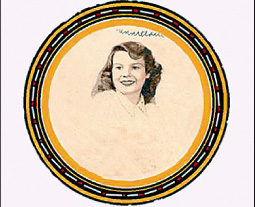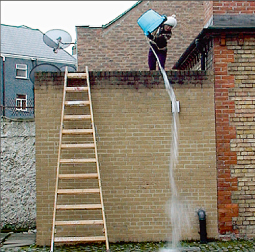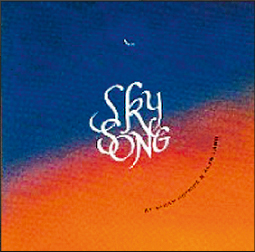|
|
| BEHIND THE GLASSLESS WINDOW Kaspars Groševs, Artist Alejandra & Aeron Nina Canell & Robin Watkins Alan Lamb & Sarah Hopkins | |
 Alejandra & Aeron. Bousha Blue Blazers. 2003 | |
| Alejandra & Aeron – Bousha Blue Blazes (Orthlorng Musorg, 2003) During their early artistic careers Alejandra Salinas and Aeron Bergman were frequently associated with field recording, which is a term used to describe recordings made outside a recording studio. Initially such recordings were intended for the creation of film soundtracks or documentation of natural sounds and various folk cultures. With the development of new technologies, field recording (also called phonography) has almost become a separate form of music. It is natural that the emergence of compact recording equipment gave a new, hyper-fast breath to the preservation of traditional music and folklore – if not in people’s minds, then at least in tapes, compact discs and digits. Lately, there have been numerous compilations and re-releases of traditional music from various parts of the world, satisfying people’s yearning for authenticity not touched by the claw of progress. Besides, the use of found sound, and musical and human imprecision in “daily folklore” has become rather popular in the last decade (possibly, thanks to the internet). Alejandra and Aeron observe the signs of our times in a relatively intimate manner, also exploring new viewpoints of cultural traditions and heritage. The recordings of the duet feature a blend of South European folklore, phonographic recordings, people’s experiences and the precision and sharpness of electronic music. For example, the album recorded in Porto in 2001 includes a track ‘Water Jota in 121344’, in which the sounds of water dripping are dispassionately arranged according to the rhythm of a Spanish folk dance. Bousha Blue Blazes is one of the most musical and sentimental albums of the duet. It was made over the Christmas holidays when Aeron Bergman’s grandmother, nicknamed Bousha, was visiting the artists’ home in Spain. Together they formed a strange trio and the result is a work telling a story or narrating the course of events. There is a short guitar intro, reminiscent of a prologue of a play, followed by the first scene (scene of the room) in which we hear a melancholy song on the radio, accompanied by household sounds, someone humming and the seemingly pointless strumming of a guitar. The first radio song is followed by the next one, a slightly livelier one, and the participation of the listeners becomes more vigorous, how¬ever, these sounds are suddenly interrupted by a clear and monotonous tone, which provides a pleasant contrast to the rough noises of the household life heard previously. The interplay of these diverse elements continues in the subsequent compositions, where droning everyday sounds are combined with sweetly mournful chords on the guitar, electronic noise, as well as the continuous singing by Bousha, constantly increasing in volume. At times her singing is cut up and manipulated like the sounds of the kitchen or the guitar, and we can hear only short phrases, but one of the most delightful parts of the compilation is the track ‘I Don’t Know’, unscathed by digital manipulation, where grandma Bousha plays the piano and sings an apparently forgotten song. At times the recital of events becomes quite blurred and arbitrary, and the musical elements and distortions caused by electronic manipulation are too monotonous. Yet it is worth getting to know the other recordings available on the artists’ website to realize that the fixed compositions serve both artists as a pure component of an unfathomable and most likely infinite whole. This is possibly the reason why Alejandra & Aeron have lately turned to sound installations and performance. A free download of this album is available at: http://alejandra-aeron.com/aa_audio. | |
 Nina Canell & Robin Watkins. 29 Infra-Ordinary Meteors. 2008 | |
| Nina Canell & Robin Watkins – 29 Infra-Ordinary Meteors (Economic Thought, 2008) The small work on this 7-inch vinyl record is in its essence very simple – it is a recording of 29 ordinary household objects falling (various pieces of metal, polyethylene pipes, cardboard rolls, wooden sticks, etc.). The sound of each object hitting the surface lasts only a few seconds, but the vinyl record is made in such way that each of the short fragments could play forever (although the record itself might first wear out before eternity arrives). Accordingly, the listener can determine the length of time it takes for each meteor to fall. It is possible that the title of the album has some connection with the novel L’infra-ordinaire by Georges Perec, where the author encourages the readers to re-assess ordinary things and to perceive the unidentifiable within them. With continual repetition each of the noises heard in the album starts to lose its connection with the actual object that made the noise, at first becoming an abstract rhythmical loop and later – a united mass, a new whole. It has to be mentioned that Nina Canell is better known as a visual artist – her impressive work Shedding Skin has undoubtedly remained in the memory of many visitors to Manifesta 7. This album has been released as a limited edition and can be purchased at http://www.canellwatkins.org, where you can also listen to a demo of all 29 loops, and find out about other joint works and projects by Canell and Watkins. | |
 Alan Lamb & Sarah Hopkins. Sky Song. 1989 | |
| Alan Lamb & Sarah Hopkins – Sky Song (Vox Australis,1989) For several decades now the sound artist Alan Lamb has been using in his works abandoned telegraph wires found in Australia’s outback, letting the wind “play” them, or manipulating them in various ways to achieve a manifold and rich sound. He also uses these wires to create installations which can be up to a kilometre long, although the human ear cannot perceive the full spectrum of the sound created. Lamb’s recordings are fashioned by flowing sound landscapes which enchant with the infinity and depth of the sound. This record is a collaboration between Lamb and the composer and cellist Sarah Hopkins. Together they have created an organic interweaving of string and wire sounds, so that at times it is difficult to recognize the source of the sound. From time to time the compositions are enhanced by their voices, which seem to be travelling via the telegraph wires, a reflection of the flutter of the wind and diffuse thuds. The total composition appears to be perfectly balanced, combining the humming, or at times the noises, made by the wires, with the flowing sounds of the cello, leaving enough time for the unhurried expression of the nuances of each element. Lamb and Hopkins achieve the impossible – they cap¬ture the Australian wind, and not only that: it seems that there are 7,686,850 square kilometres confined within the hour long opus. The CD can be purchased at http://www.sarahhopkins.com. | |
| go back | |







